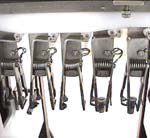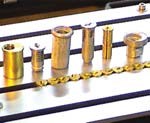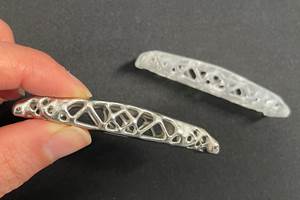Locking into a New Plating Line
The new plating line at CompX helped it save money and time...
CompX International Security manufactures some of the finest security locks in the world. Its reputation has been such that it needed to expand its facility in Greenville, SC. The company knew, however, that the current electroplating system had to be revaluated as well. Existing rack and barrel lines had proven too labor intensive and used up too much valuable floor space to allow the company to expand beyond its current capabilities and still remain competitive. Company President David Bowers looked into alternative processing technology that would allow for the increased production the market was demanding while addressing issues of space and overall production costs.
In his search, Mr. Bowers learned of a fully automated processing technology that appeared to offer some alternatives to traditional rack and barrel processing. Mr. Bowers felt this may be the solution to the company's plating line dilemma. Mr. Bowers and engineering and facility manager, Jerry Green visited the manufacturer to learn more about the company and its experience in electroplating automation.
They learned how the plating system's patented part processing technology and custom designed enclosed plating systems could not only address the issue of labor cost and floor space but actually operate more efficiently and improve the quality of their locks.
Parts are processed continuously using a single piece flow approach, versus the batch approach of conventional rack plating lines. Individual parts are held by universal, non-marking plating clips designed to hold a large variety of different size and shape parts. Parts are loaded and unloaded using a vibratory track, and pick-and-place robotic feeder.
The continuous line plates copper and bright nickel as well as other finishes (See Fig. 1) on zinc diecast, brass and other base metals. CompX also has a conventional rack line for chromium and brass finishes. This line is scheduled for replacement with an SFT line later next year. The company also has a barrel line where it plates zinc, copper, brass, nickel and bright nickel and an oxidizer for antique finishes.
| Figure 1. Plating Process on the SFT line at CompX | |
| 1. Load | |
| 2. Soak clean | 30 sec |
| 3. Rinse | 3 sec |
| 4. Rinse | 3 sec |
| 5. Rinse | 3 sec |
| 6. Electroclean | 30 sec |
| 7. Rinse | 3 sec |
| 8. Rinse | 3 sec |
| 9. Rinse | 3 sec |
| 10. Acid activate | 3 sec |
| 11. Rinse | 3 sec |
| 12. Rinse | 3 sec |
| 13. Rinse | 3 sec |
| 14. Copper strike | 30 sec |
| 15. Copper plate | 120 sec |
| 16. Dragout | 3 sec |
| 17. Rinse | 3 sec |
| 18. Rinse | 3 sec |
| 19. Rinse | 3 sec |
| 20. Anodic clean | 30 sec |
| 21. Rinse | 3 sec |
| 22. Rinse | 3 sec |
| 23. Rinse | 3 sec |
| 24. Acid activate | 3 sec |
| 25. Rinse | 3 sec |
| 26. Rinse | 3 sec |
| 27. Rinse | 3 sec |
| 28. Bright nickel | 120 sec |
| 29. Dragout | 3 sec |
| 30. Rinse | 3 sec |
| 31. Rinse | 3 sec |
| 32. Rinse | 3 sec |
| 33. DI rinse | 3 sec |
| 34. Dry | 30 sec |
| 35. Unload | |
When the information about the potential plating line was discussed with the manufacturing engineers at CompX, some were not easily convinced that the system could offer the results described. Bob Edwards and Wayne Holbrook of CompX worked closely with the manufacturer in developing a basic prototype plating cell. The cell was sent to CompX, and, after several weeks of testing, both men were convinced that the system would perform with the results everyone now expected. Parts are uniformly plated from beginning to end. Each time a part is run, the quality is the same.
The plating line computer controls the addition of several of the components in the nickel and copper tanks. The system is used to monitor temperature in the other tanks on the line and helps the efficiency and consistency.
Since the line was very compact and the process cells completely enclosed, CompX saved considerable money in the site plan. The plan was to installed the SFT line in the new air-conditioned manufacturing area, since the ventilation requirements were so low and no make-up air was needed. This also allowed CompX to save valuable manufacturing space, since the line was only 50% the size of the rack system.
Once the machine was built, a complete and extensive run-off was performed right at the factory. Modular construction allowed for the system to then be disassembled and shipped to CompX. The entire line was installed, leached and chemistry added in a short two weeks. Once the system went through the qualification and system de-bug, CompX was ready to see what this system would really do.
"One operator can load the entire line, compared to the 13 operators required to load on the rack line. Loading and turnaround time on jobs are now a fraction of what they once were. Reducing the labor in the plating area is obviously a tremendous value," said Jerry Green.
"But to reduce water by 75% and decrease the waste just makes a lot of sense, and this is only a part of the savings. Our quality in corrosion protection has improved as well as the overall appearance. All of this while reducing the amount of plating on the parts. The chemistry was slightly modified to improve current density as well as part-to-part distribution. Our overall utility costs on this line are half of what they are with our traditional rack line. We were also able to start the system with only 20% of the chemical makeup cost compared to the rack line; this was a savings in itself of $48,000.00. We can also get a much faster turn around on jobs. Jobs that took more than two hours on the rack line now take only 17 minutes on the new line. This system clearly has proven itself."
To learn more vist Technic, Inc..
Related Content
Possibilities From Electroplating 3D Printed Plastic Parts
Adding layers of nickel or copper to 3D printed polymer can impart desired properties such as electrical conductivity, EMI shielding, abrasion resistance and improved strength — approaching and even exceeding 3D printed metal, according to RePliForm.
Read MoreSuccessful South African Plater Beating the Odds
Remaining focused on quality and reliability, Team Plating Works stays profitable in a volatile and challenging economy.
Read MoreNanotechnology Start-up Develops Gold Plating Replacement
Ag-Nano System LLC introduces a new method of electroplating based on golden silver nanoparticles aimed at replacing gold plating used in electrical circuits.
Read MoreAdvantages to Pumped Eductor Agitation
Not all agitation methods are created equally. Pumped agitation with eductor nozzles can improve process tanks and quickly show a reduction in operating costs while keeping staff safe, following environmental legislation and preventing pollution.
Read MoreRead Next
A ‘Clean’ Agenda Offers Unique Presentations in Chicago
The 2024 Parts Cleaning Conference, co-located with the International Manufacturing Technology Show, includes presentations by several speakers who are new to the conference and topics that have not been covered in past editions of this event.
Read MoreDelivering Increased Benefits to Greenhouse Films
Baystar's Borstar technology is helping customers deliver better, more reliable production methods to greenhouse agriculture.
Read MoreEpisode 45: An Interview with Chandler Mancuso, MacDermid Envio Solutions
Chandler Mancuso, technical director with MacDermid Envio discusses updating your wastewater treatment system and implementing materials recycling solutions to increase efficiencies, control costs and reduce environmental impact.
Read More

























